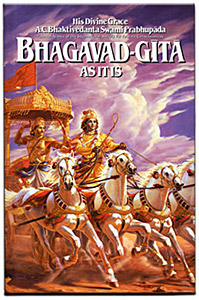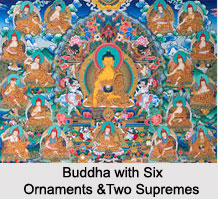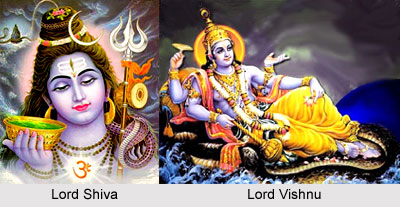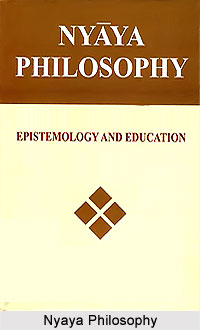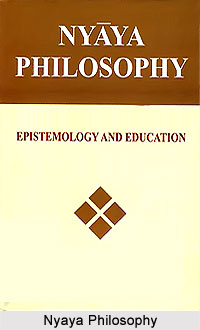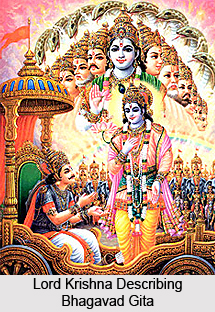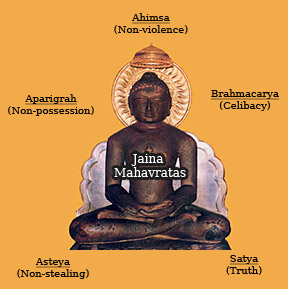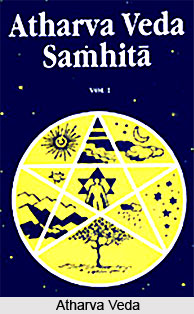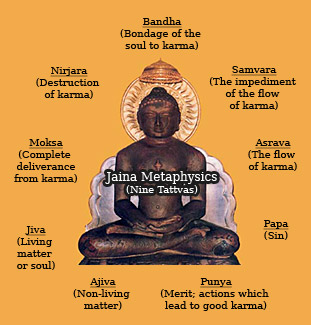The connection of soul with matter is seen most clearly in the fact that soul is clothed with material bodies. It fills up the body completely, because it can expend and shrink so that it can equally completely penetrate a body of an elephant as well as a body of an ant in two existences following one after the other. There are 5 bodies according to the doctrine of Jainas. They are:
1. Audarika-sanra, the earthly body of crude substance, peculiar to animals and human beings.
2. Vaikriya-sarira, the "metamorphic" body consisting of fine matter. This can change its form and size according to the wish of the owner. It is present among gods, beings from hell and some animals on account of their nature, but even human beings can obtain it on the basis of their higher perfection.
3. Aharaka-sarira, the body of transference (or "projectile" body). This consists of a good and pure substance and is without an active or a passive resistance. It is created by an Apramatta-samyata-ascetic for a brief period, and after being equipped with it, he gets information from a teacher on difficult dogmatic questions.
4. Taijasa-sarira, the fiery body. This consists of fire-atoms and serves to digest the food that is eaten. It can be used by the ascetics to burn other beings or things.
5. Karmana-sarira, the Karmic body. This is a recepta-culum of the Karma-matter. It changes every moment, because the soul constantly assimilates a new Karma and exhausts the existing one.
Of these five bodies, every following one is finer than the preceding one, but contains more material points than this; it is thus thicker. Every being wandering in Samsara including also the one which is on its way from one from of existence to a new one, has constantly two bodies: the fiery- and the Karmic body. These two bodies do not feel any pleasure or pain and do not possess any limbs. There is no resistance against them; they pass through everything coming in their way so that they can measure the whole world and must make a halt at its borders. A being can possess at the same time at the most two other bodies besides these two in a form of existence, but the "metamorphic" and "projectile" bodies cannot appear together, and the latter appears only together with an earthly body. Of the five bodies only the earthly can be perceived by eyes by a common man but all of them have, like all material things, smell taste, colour and touch.
The earthly body is extremely different among the earthly beings. There are Jivas which have one individual body for themselves, but there are others which have one body among several; such a common body is possessed by plants (garlic, onion, etc.). The earthly body of many beings is so fine that it can be noticed by us only when they appear in large numbers, as it is the case with many types of animals (elementary beings and plants).
The body of many beings can be moved by their wish and volition; the body of the others cannot be set into motion by them, but they can be moved from one place to the other by alien influences coming from out side.
Depending upon the shape, the body of a being can be symmetrical or asymmetrical. Jainas distinguish 6 different types of statures (Sarhsthana), from a complete symmetry to its absolute opposite. The human body is at the basis to determine the concept of symmetry; the following explanation is given: one should image a man sitting in the Paryaiika-posture; i.e. he crosses the legs and puts the hands on the navel. If one imagines that the two knees are connected by one line, and each one straight from the right shoulder to the left knee and from the left shoulder to the right kind from the forehead to the hands, then one gets four lines. If they are similar to one another, then there is symmetry; if they are not, then one of the other five statures results.
The six statures are:
1. Samacaturasra-samsthana:The body is completely symmetrical.
2. Nygrodhaparimandala-samssthana: The upper part of the body is symmetrical; the lower is not; thus the body is like a fig-tree, which is beautiful and big above, but small and ugly below.
3. Sadi-samsthana: The body below the navel is symmetrical, which the upper part is asymmetrical.
4. Kubja-samsthana: The body is hunch-backed, i.e. hands, feet, head and neck are symmetrical, but not the breast and the stomach.
5. Vamana-samsthana: The body is dwarf-like, i.e. breast and stomach are symmetrical, but not the hands and feet, etc.
6. Hunda-samsthana: The whole body is asymmetrical.
The firmness with which the bones of the earthly body are connected with one another is significant, particularly among the higher organized beings. The strength of the union of the joints (Samhanana) is of 6 grades:
1. Vajra-samhanana: This is the first-class union of the joints; the two bones are to some extent hooked to one another, a stick (Vajra) is drawn through the place of the joint, and the whole is bound by a tissue.
2. Rasbha-naraca-samhanana: This connection is not so firm like the preceding one because the pin is missing.
3. Naraca-Samhanana: This union is again weaker, because even the tissues are missing.
4. Ardhaonaraca-sanhanana: This union is on the one side like the preceding one, while on the other side; the bones are only virtually pressed against one another and are nailed
5. Kilika-samhanana: Still weaker union where the bones are only pressed against one another and nailed.
6. Savarta-(or chaedaprstha-) samhanana: A completely weak union in which the edges of the bones only touch one another.
These Samhananas play a great role in the Jaina dogmatism. Only the first four make a meditation, i.e. affixing and concentration of a thought possible only the best, i.e the first union of the joints allow the highest type of concentration which precedes salvation.


